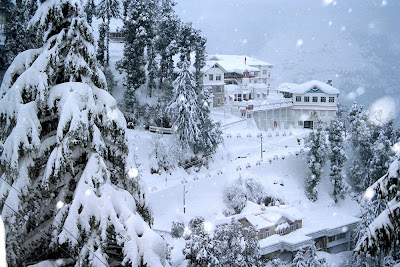Himalayas
The Himalayas are not merely a geographical feature, a range of mountains; they epitomize a people's civilizational identity that goes back to the dawn of history. If these majestic mountains were not there, the rain clouds sweeping up from the Indian Ocean would have passed over the Indian subcontinent into central Asia leaving it a burning desert.
The Himalayas are not merely a geographical feature, a range of mountains; they epitomize a people's civilizational identity that goes back to the dawn of history. If these majestic mountains were not there, the rain clouds sweeping up from the Indian Ocean would have passed over the Indian subcontinent into central Asia leaving it a burning desert.
Birth of Himalayas Archaeological evidence reveals the history of Himalayas, according to which urban civilization first emerged in the valleys of the rivers coursing down from the Himalayan mountains. When man elsewhere was cautiously emerging from his cave shelters, spectacular cities flourished at Mohenjodaro and Harappa in the Indus valley.

Earth Movements (Facts About Himalayan Mountain Ranges)The Himalayan mountain system developed in a series of stages 30 to 50 million years ago. The Himalayan range was created from powerful earth movements that occurred as the Indian plate pressed against the Eurasian continental plate. The earth movements raised the deposits laid down in the ancient, shallow Tethys Sea (on the present site of the mountains) to form the Himalayan ranges from Pakistan eastward across northern India, and from Nepal and Bhutan to the Myanmar (Burmese) border. Even today the mountains continue to develop and change, and earthquakes and tremors are frequent in the area.
Mechanics of Mountain Formation
To understand the fascinating mechanics of the collision of India with Asia we must first look beneath the earth's surface. The continents are carried by the Earth's tectonic plates like people on an escalator. There are currently 7 giant plates sliding across the Earth's surface, and a handful of smaller ones. There may have been more or fewer plates in the past. Currently they slide, collide, and recede from one another at rates of 1-20 cm/year. They are driven by internal heat deep in the earth that is able to escape efficiently only by convection. Convection is the process that drives hot currents of gas or liquid upwards because they are less dense, and cold currents of liquid downwards because they are more dense.

Continental Plates
In some ways, the continents are like giant accumulations of rock debris lying atop the tectonic plates. Continents are the " Scum of the Earth," consisting mostly of light minerals like quartz, which can't sink into the earth's dense mantle. For at least 80 million years the oceanic Indian Plate continued its inexorable collision with southern Asia, including Tibet. The heavy ocean floor north of India acted like a giant anchor, plunging rapidly into the mantle, and dragging the Indian continent along with it, northward, towards Tibet.
As the plates collided, the sinking ocean floor generated volcanoes in southern Tibet because the rock at the top of the descending plate melted, from friction and the huge pressures of collision. However, by 25 million years ago the fast moving Indian continent had almost entirely closed over the intervening ocean, squeezing the sediments on the ocean floor. Since the sediments were lightweight, instead of sinking along with the plate, they crumpled into mountain ranges -- the Himalayas.
By 10 million years ago the two continents were in direct collision and the Indian continent, because of its enormous quantity of light quartz-rich rocks, was unable to descend along with the rest of the Indian plate. It was at about this time that the anchor chain must have broken; the descending Indian plate may have fallen off and foundered deep into the mantle.
Future of the Himalaya
Over periods of 5-10 million years, the plates will continue to move at the same rate, which allows us to forecast fairly reliably how the Himalaya will develop. In 10 million years India will plow into Tibet a further 180km. This is about the width of Nepal. Because Nepal's boundaries are marks on the Himalayan peaks and on the plains of India whose convergence we are measuring, Nepal will technically cease to exist. But the mountain range we know as the Himalaya will not go away.
This is because the Himalaya will probably look much the same in profile then as it does now. There will be tall mountains in the north, smaller ones in the south, and the north/south width of the Himalaya will be the same. What will happen is that the Himalaya will have advanced across the Indian plate and the Tibetan plateau will have grown by accretion. One of the few clues about the rate of collision between India and Tibet before the GPS measurements were made was the rate of advance of Himalayan sediments across the Ganges plain. There is an orderly progression of sediments in front of the foothills.
No comments:
Post a Comment